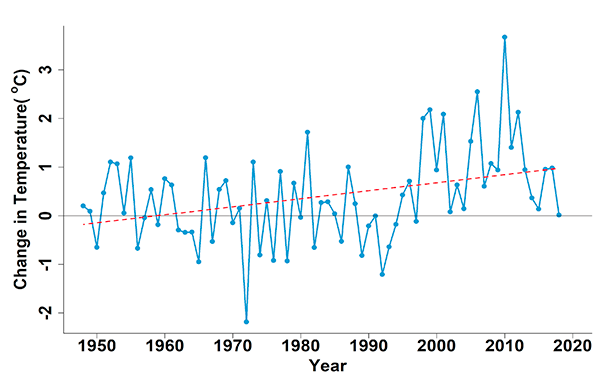Understanding Climate Change
In northern regions, warming is more pronounced than elsewhere in the world. While the Earth has warmed by 0.8°C over the last 70 years, Quebec’s average annual temperature has increased by 1.1°C.

Figure 1. Changes in the average annual temperature observed in Quebec from 1948 to 2018 (blue line) and trend line (red dotted line). Data source: Vincent et al. 2015.
But why are the more northern regions of the globe warming faster?
One of the main reasons is the reduction in albedo. Snow and ice are light-coloured surfaces that reflect back a lot of the solar radiation they receive. In contrast, water absorbs almost all solar radiation and reflects back only a small portion of it.
With global warming, the amount of snow and ice covering the Earth is decreasing, reducing this reflection (the albedo effect). Darker land and water surfaces absorb more incident solar radiation, adding more heat to the climate system. The initial warming is then amplified, which, in turn, melts more snow and ice.
The increased absorption of solar energy by the oceans is also important. As a result, this additional heat, which must dissipate in the autumn, slows the formation of surface ice. This situation then generates a postponement of the usual freezing dates.
What is the difference between the weather and the climate?
Climate refers to conditions observed over a long period of time at a given location. It is defined by the climate normal values calculated over 30 years. The climate is therefore much more stable than the weather and changes very slowly.
Weather refers to the conditions in a specific place, today or in the near future. It can change quickly. For example, in Quebec, it is not uncommon to see a temperature difference of 10°C between night and day.
People are used to adjusting their day-to-day behaviours based on the weather, as short-term temperature changes are easier to understand. However, it is difficult to measure the amount and impact of climate change when the temperature increases by 2°C or 4°C on average over a large area and over a few decades. Yet the scale and speed at which climate change is taking place is alarming. It is already having an impact on the weather on a daily basis, and this will continue to do so.
In Quebec, rising temperatures are causing an increase in annual precipitation and in the intensity and frequency of certain extreme events such as heat waves and heavy precipitation. In contrast, other conditions are decreasing such as the duration of snow cover, the frequency of cold snaps and the duration and extent of frozen sea ice.
Other climate peculiarities are seen, depending on the region and season. For example, a drop in the relative sea level is projected along the shores of Hudson Bay, while water levels in the Gulf of St. Lawrence should rise. Solid precipitation such as snow will increase in the north, while a downward trend is projected in the south.
Learn more about the precipitations.